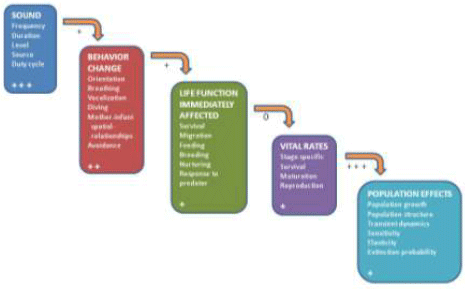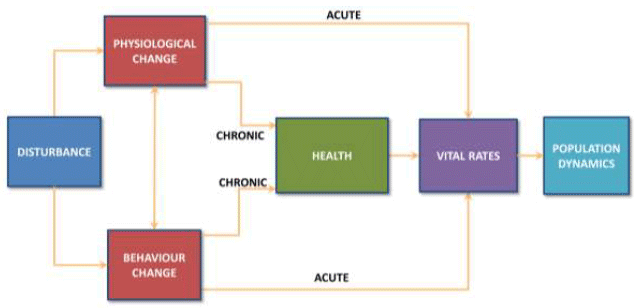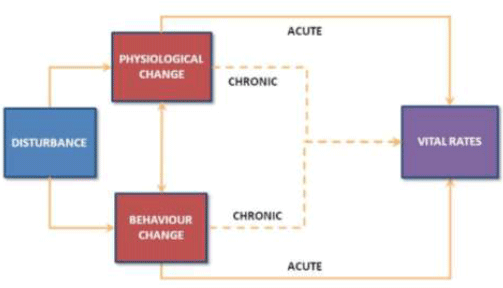Scottish Marine and Freshwater Science Volume 5 Number 2: A Protocol for Implementing the Interim Population Consequences of Disturbance (PCoD) Approach...
Report on developing a protocol to implement the interim Population Consequences of Disturbance (PCoD) Approach: quantifying and assessing the effects of UK offshore renewable energy developments on marine mammal populations
Introduction
This report describes a protocol for implementing an interim version of the Population Consequences of Disturbance ( PCoD) approach to assess and quantify the potential consequences for marine mammal populations of any disturbance and/or injury that may result from offshore energy developments. The basic PCoD approach was developed by a US Office of Naval Research ( ONR) Working Group on the Population Consequences of Acoustic Disturbance ( PCAD). It provides a formal, mathematical structure that can be used to implement the conceptual framework for investigating PCAD that was presented by the US National Research Council's Committee on Characterizing Biologically Significant Marine Mammal Behavior in its 2005 report ( NRC, 2005). The interim PCoD approach has been designed to be suitable for assessing the potential effects associated with the construction and operation of all types of marine renewables devices on populations of marine mammals in UK waters. It was developed during discussions that took place at a 2012 workshop on 'Assessing the Risks to Marine Mammal Populations from Renewable Energy Devices' (Lusseau et al. 2012), which was jointly funded by Countryside Council for Wales ( CCW - now Natural Resources Wales ( NRW)), the Joint Nature Conservation Committee ( JNCC) and the Natural Environment Research Centre ( NERC). The approach has benefited greatly from subsequent consultations with stakeholders, and feedback from presentations at meetings of the ONR Working Group. We have also made use of discussions and presentations given at a workshop funded by NERC and Marine Scotland on 'The Use of Individual-based Models of Animal Movement to Assess the Effects of Marine Renewables'. The latter workshop allowed us to develop a methodology for scaling up estimates of the effects of one day of construction on individual animals to cover the entire duration of construction, and for evaluating the cumulative effects of multiple developments on individual Management Units ( MUs) for affected species.
We believe that this protocol can be used by regulators and developers to evaluate the potential effects of individual project proposals over the course of their construction and operation, and to assess the cumulative impacts of multiple developments on marine mammal populations. In particular, we have attempted to provide a rigorous, auditable and quantitative methodology for determining how the potential disturbance and injury to marine mammals that may be associated with these proposals might impair the ability of individual animals to survive, breed, reproduce, or rear young, and to quantify how this impairment may affect the abundance of the species concerned within the Management Units ( MUs) identified by the Inter-agency Marine Mammal Working Group established by the Statutory Nature Conservation Bodies ( SNCBs)(Anon. 2013). The overall approach described here is similar to that developed independently by Thompson et al. (2013) to assess the potential effects of pile driving on harbour seals in the Moray Firth MU. However, it has a more formal structure, accounts for more sources of uncertainty, and has been generalised to a range of marine mammal species.
Specifically, our aim has been to provide a protocol that can be used in the preparation of Environmental Statements ( ESs), to inform project-level Habitats Regulations Appraisals ( HRAs), including Appropriate Assessments, and in the determination of licence applications and conditions. The protocol provides estimates of the potential effects of death, injury, and behavioural disturbance associated with proposals for marine renewable energy developments on the conservation status of the populations of five priority marine mammal species:
- harbour seal ( Phoca vitulina)
- grey seal ( Halichoerus grypus)
- bottlenose dolphin ( Tursiops truncatus)
- harbour porpoise ( Phocoena phocoena)
- minke whale ( Balaenoptera acutorostrata)
The protocol has been designed to use the kinds of information that are likely to form part of an offshore energy project's ES and HRA. Methods for estimating the number of marine mammals of each species that may experience death, injury or behavioural disturbance during one day of construction for offshore wind farms are currently available ( e.g. Donovan et al. 2012, Nedwell et al. 2007) , and we have assumed that developers will provide such estimates. Ideally, these methods should also be used to provide estimates of the uncertainties involved in the calculation of these values (see 'Sources of Uncertainty' section). Sparling & Lonergan (2013) were able to estimate the risk of collision between harbour seals and the SeaGen tidal energy array at Strangford Lough. However, we appreciate that providing such estimates will be problematic for most developments of this kind. In such circumstances it is possible to use a range of values for the number of animals that may be affected, and to investigate the population implications of these values.
In order to illustrate how the protocol could be used in practice, we consider the potential effects of the construction of two hypothetical wind farms off the Aberdeenshire coast over a period of two years on the five priority species in their relevant MUs. Additionally, we investigate the cumulative effects of the simultaneous operation of a hypothetical tidal energy array in the same region at the same time as this hypothetical construction work.
PCAD, PCoD and the Interim PCoD Approach
In 2005, a panel convened by the National Research Council of the United States National Academy of Sciences ( NRC) published a report on biologically significant effects of noise on marine mammal populations ( NRC, 2005). The panel developed what they referred to as a "conceptual model" that outlines the way marine mammals respond to anthropogenic sound, and how the population level consequences of these responses could be inferred on the basis of observed changes in behaviour. They called this model Population Consequences of Acoustic Disturbance or ' PCAD' ( Fig. 1).
Figure 1. The Population Consequences of Acoustic Disturbance ( PCAD) model developed by the National Research Council's panel on the biologically significant effects of noise. After Fig. 3.1 in NRC (2005). The number of + signs indicates the panel's evaluation of the relative level of scientific knowledge about the links between boxes, 0 indicates no knowledge. These links were described by the panel as "transfer functions".
In 2009 the ONR set up a working group to transform this conceptual model into a formal mathematical structure and to consider how that structure could be parameterised using data from a number of case studies. The ONR working group also extended the PCAD model to consider forms of disturbance other than noise, and to address the impact of disturbance on physiology as well as behaviour. The current version of that model, which is based on case studies of elephant seals, coastal bottlenose dolphins, northern right whales and beaked whales, is now known as PCoD (Population Consequences of Disturbance). It is shown in Figure 2, and described in more detail in New et al. (in press).
The PCoD model shows how disturbance may affect both the behaviour and physiology states of an individual, and how changes in these states may influence that individual's vital rates (see Glossary) either directly (an acute effect) or indirectly via its health (a chronic effect).
For example, exposure to high levels of sound may result in hearing damage (a physiological effect) through a permanent increase in the threshold for hearing at a particular frequency (Permanent Threshold Shift - PTS). This could have an acute effect on survival, because the affected individual might be less able to detect predators. It could also have a chronic effect on reproduction via the individual's health, because it might be less able to locate and capture prey. Similarly, behavioural changes in response to disturbance could have an acute effect on survival if they result in a calf being separated from its mother. They could have a chronic effect on reproduction, via body condition, if they result in the disturbed animal spending less time feeding or in activities that conserve energy, such as resting.
Figure 2. The PCoD model of the population consequences of disturbance developed by the ONR working group on PCAD (modified from Fig.4 of New et al., in press). See Glossary for a definition of the terms used in the diagram.
Using case studies of elephant seals (New et al. (in press), and Schick et al. (2013)) and bottlenose dolphins (New et al. 2013) it was possible to show how changes in behaviour in response to disturbance could affect the energy reserves of adult females, and to estimate the implications of these changes for the probability of giving birth and offspring survival. The consequences of these changes for population dynamics could then be inferred from the number of animals that might be affected by disturbance and the size of the population of which they are part. Nabe-Nielsen et al. (2011) used a similar approach to assess the potential impacts of wind farm operation on harbour porpoises in Inner Danish Waters.
Unfortunately, the empirical information that is required to parameterise the PCoD model developed by the ONR Working Group does not exist for the five priority species we are considering here. We have therefore used a simplified version of this model ( Figure 3) which was developed at the workshop on 'Assessing the Risks to Marine Mammal Populations from Renewable Energy Devices' (Lusseau et al. 2012). The information required to quantify the potential effects of behavioural and physiological changes on vital rates, shown by the dotted lines in Figure 3, was obtained using an expert elicitation process (Runge et al. 2011, Martin et al. 2012) which is described in the next section.
Figure 3. A simplified version of the PCoD model shown in Figure 2 that is being used in the interim PCoD approach. The transfer functions that determine the chronic effects of physiological change and behavioural change on vital rates are represented with dotted lines to indicate that the form of these functions has been determined using the results of an expert elicitation process rather than using empirical evidence. See Glossary for definitions of the terms used in this diagram.
Expert Elicitation: Background and Methodology
Expert elicitation is a formal technique that is now widely used in conservation science to combine the opinions of many experts in situations where there is a relative lack of data but an urgent need for conservation decisions (Martin et al. 2012). Martin et al. (2012) describe how this technique can be used to access substantive knowledge on particular topics held by experts. The technique can also be used to translate and combine information obtained from multiple experts into quantitative statements that can be incorporated into a model, minimize bias in the elicited information, and ensure that uncertainty is accurately captured. The formal process of expert elicitation therefore avoids many of the well documented problems, described in detail by Kahneman (2012), that arise when the judgements of only a few experts are canvassed.
We developed our elicitation procedure in collaboration with Professor Mark Burgman, director of the Australian Centre of Excellence for Risk Analysis at the University of Melbourne, who has worked closely with the ONR PCAD working group. In particular, we used the 4-step interval approach developed by Speirs-Bridge et al. (2010) to provide reliable estimates of the confidence that experts attached to their opinions. In addition, we took account of research which has shown that the reliability of results from an expert elicitation process can be improved if experts are asked to consider their opinions in the light of what other experts have said (Burgman et al. 2011). This is known as the Delphi process (Delbecq et al. 1975). MacMillan & Marshall (2006) provide an example of the use of this process in a study of the environmental requirements of capercaillie in Scotland. The procedures used in the expert elicitation, the criteria used in the initial selection of experts, and the statistical analysis used to estimate the parameters of the relationships required by the interim PCoD model from the results of this elicitation are described in detail in Appendix 1 and in Donovan et al. (in press).
We asked the experts who agreed to participate in our survey to focus on the potential population consequences of changes in hearing ability resulting from PTS, and on disturbance caused by noise and increased vessel traffic associated with offshore renewable energy developments. We hypothesized that the vital rates most likely to be affected by PTS are survival (for all age classes) and the probability of giving birth. The ONR PCAD working group has concluded that disturbance is most likely to affect calf and juvenile survival, and the probability of giving birth. We therefore only asked the experts for their opinions on these vital rates.
We also asked the experts to consider both PTS and disturbance as binary responses. That is, an individual can be categorised as either having experienced PTS or not having experienced PTS (although we recognise that the extent of PTS will vary depending on the sound exposure level that the individual experienced), and as either being disturbed for one day or not disturbed. Following Southall et al. (2007), PTS was defined as a non-recoverable elevation of the hearing threshold that occurs under conditions that cause a 40dB temporary shift in the threshold for hearing. Currently, most Environmental Statements use Southall et al.'s (2007) injury criteria to calculate the sound pressure or sound exposure levels that are likely to result in PTS as defined in this way.
We defined disturbance as any change in behaviour that is likely to impair an individual's ability to survive, breed, reproduce, or raise young, or that is likely to result in that individual being displaced from an area for a longer period than normal. This is roughly equivalent to all the behaviours with a score of 5* or higher on the "behavioural response severity scale" drawn up by Southall et al. (2007). These behaviours include changes in swimming and breathing patterns, sustained avoidance of an area, and prolonged changes in vocal behaviour.
We asked the experts to choose values for the two parameters which determine the shape of the relationship between the number of days of disturbance experienced by an individual and its vital rates shown in Figure 4 so that it best represented the way in which they thought disturbance might have an effect. We recognise that the proposed relationship between days of disturbance and changes in vital rates is highly simplified. However, in the absence of any empirical data on the shape of this relationship for the five priority species, it is hard to justify proposing a more complex form. There is clearly an urgent need for research on the actual form of this relationship.
We also asked experts to comment on the opinions they had provided and on the expert elicitation process itself. These comments are summarised in Appendix 1.
This expert elicitation process was designed specifically to provide parameter values for the functions that form part of the model shown in Figure 3. Those values should not be used to infer how disturbance might affect vital rates outside of the context of this model. In addition, the expert elicitation and the subsequent analysis of the results from the elicitation process were designed to capture the uncertainty expressed by individual experts, and the variability among experts in their opinions. It would therefore be entirely inappropriate to derive simple summary statistics from this analysis.
Contact
There is a problem
Thanks for your feedback


